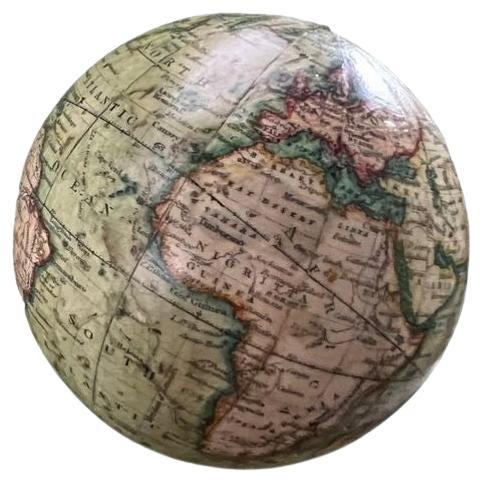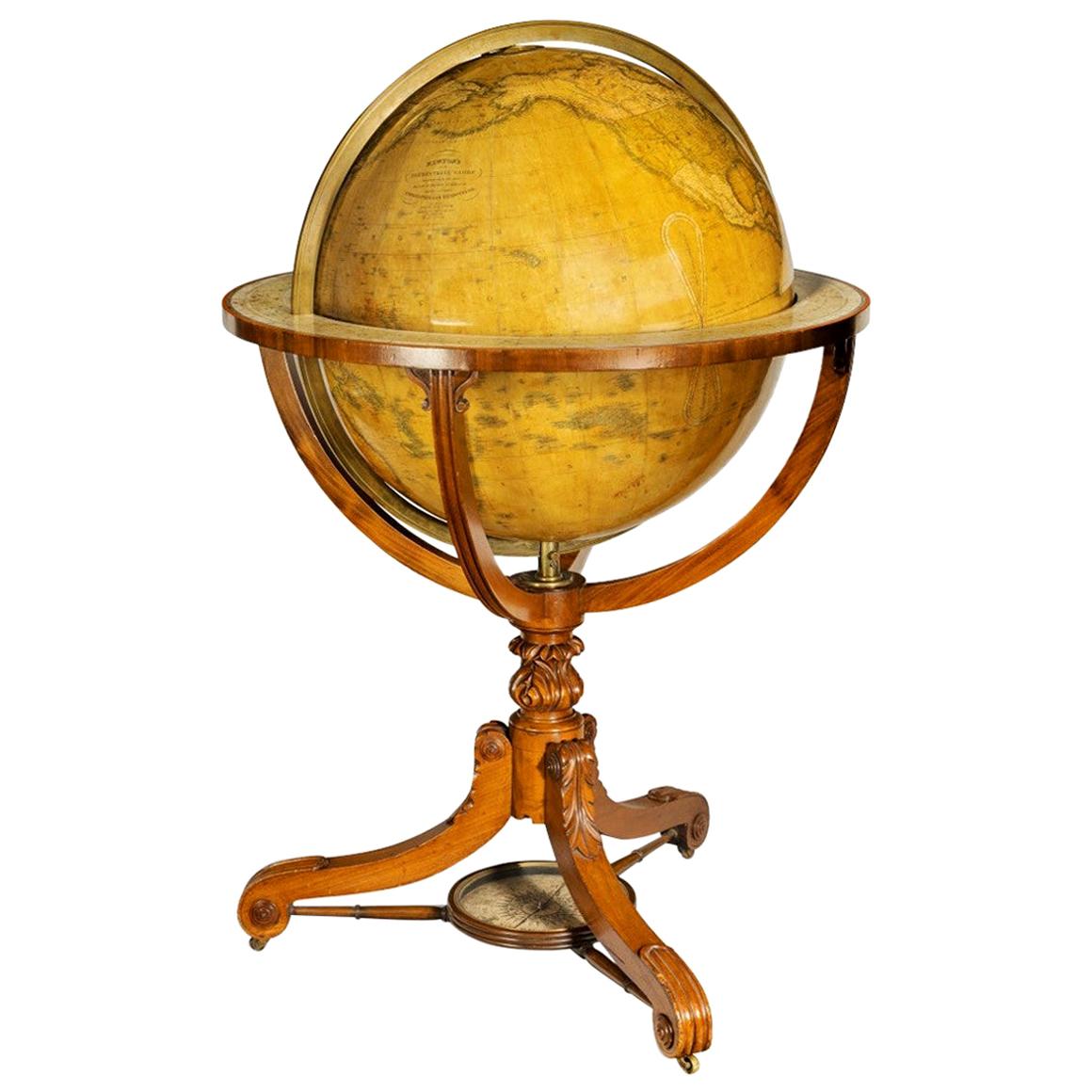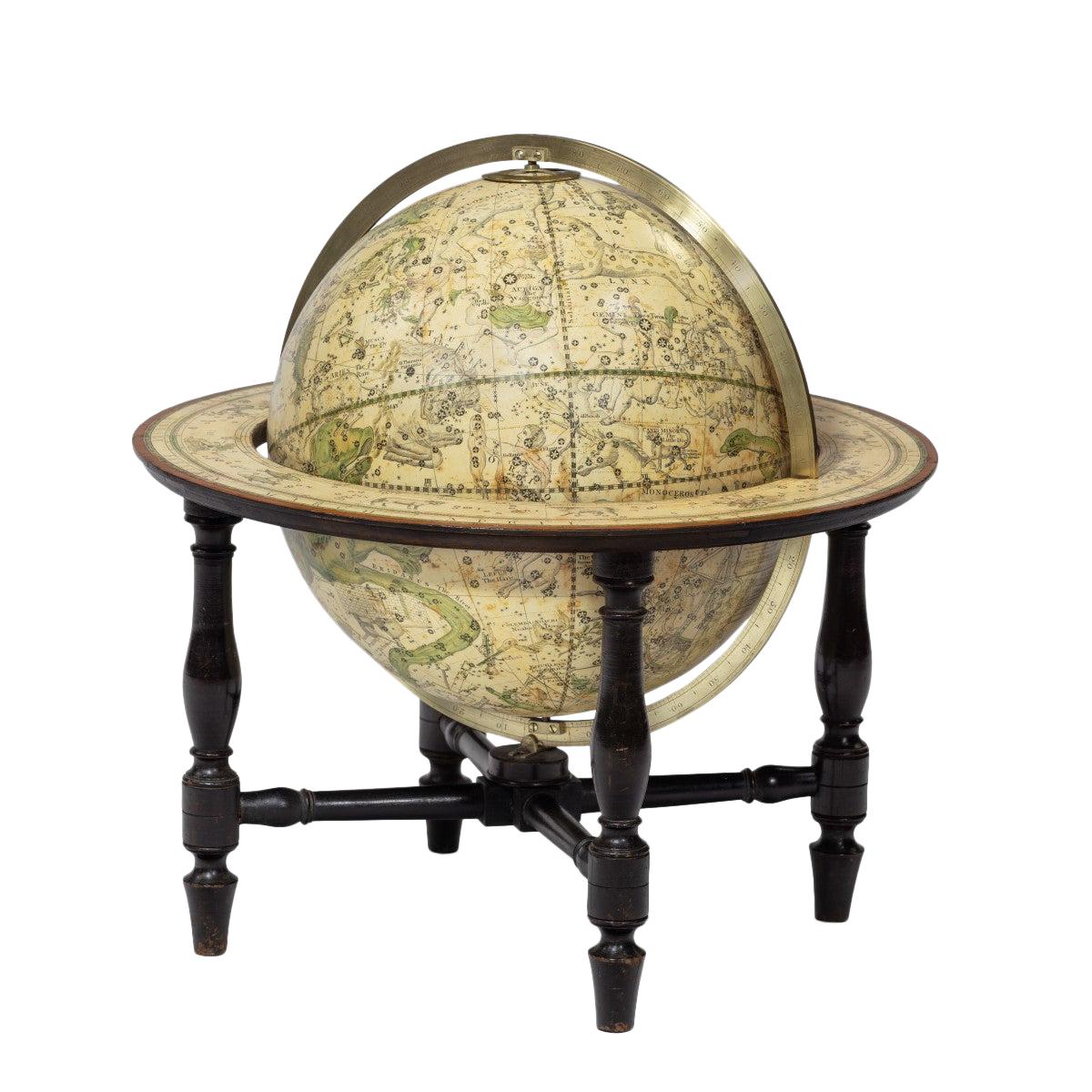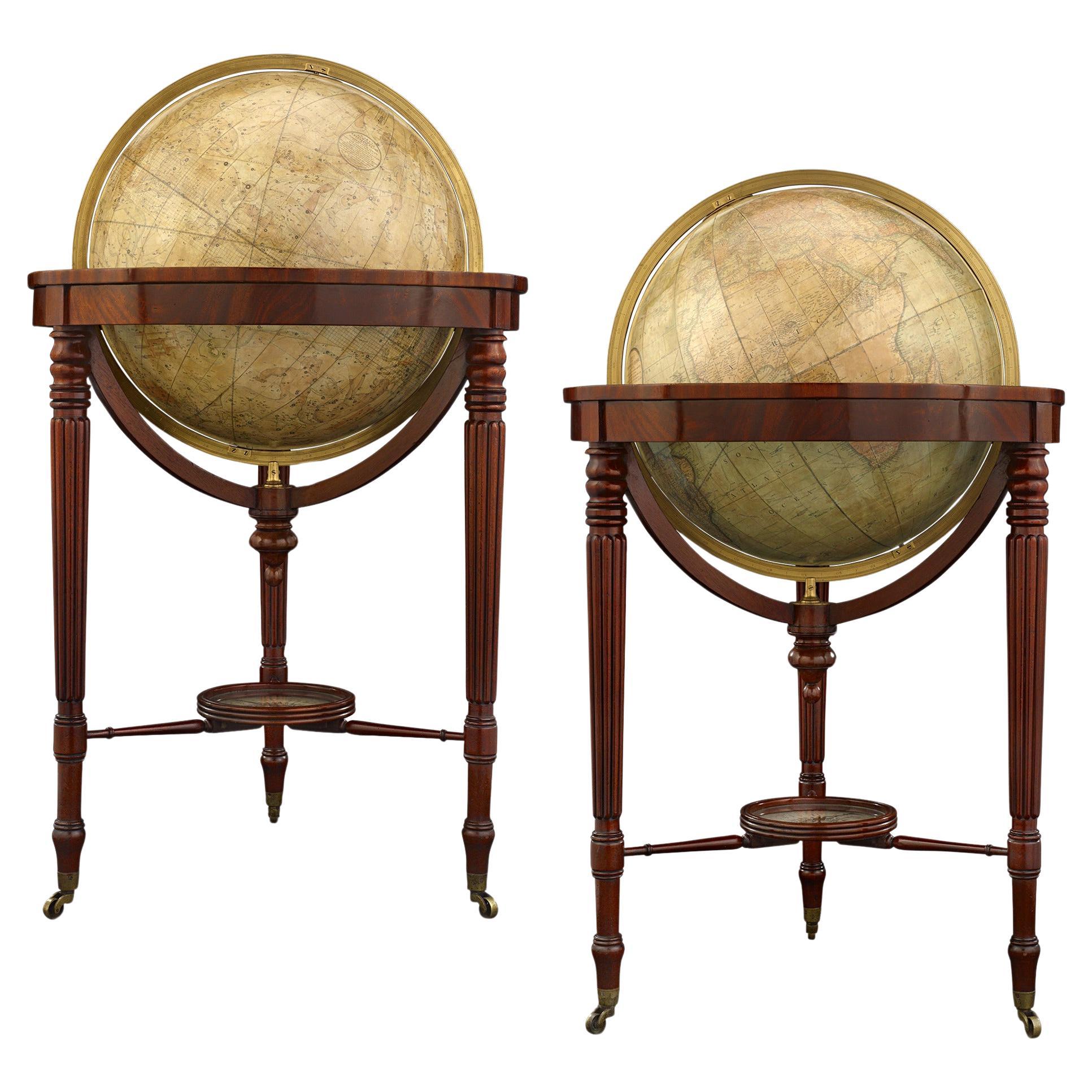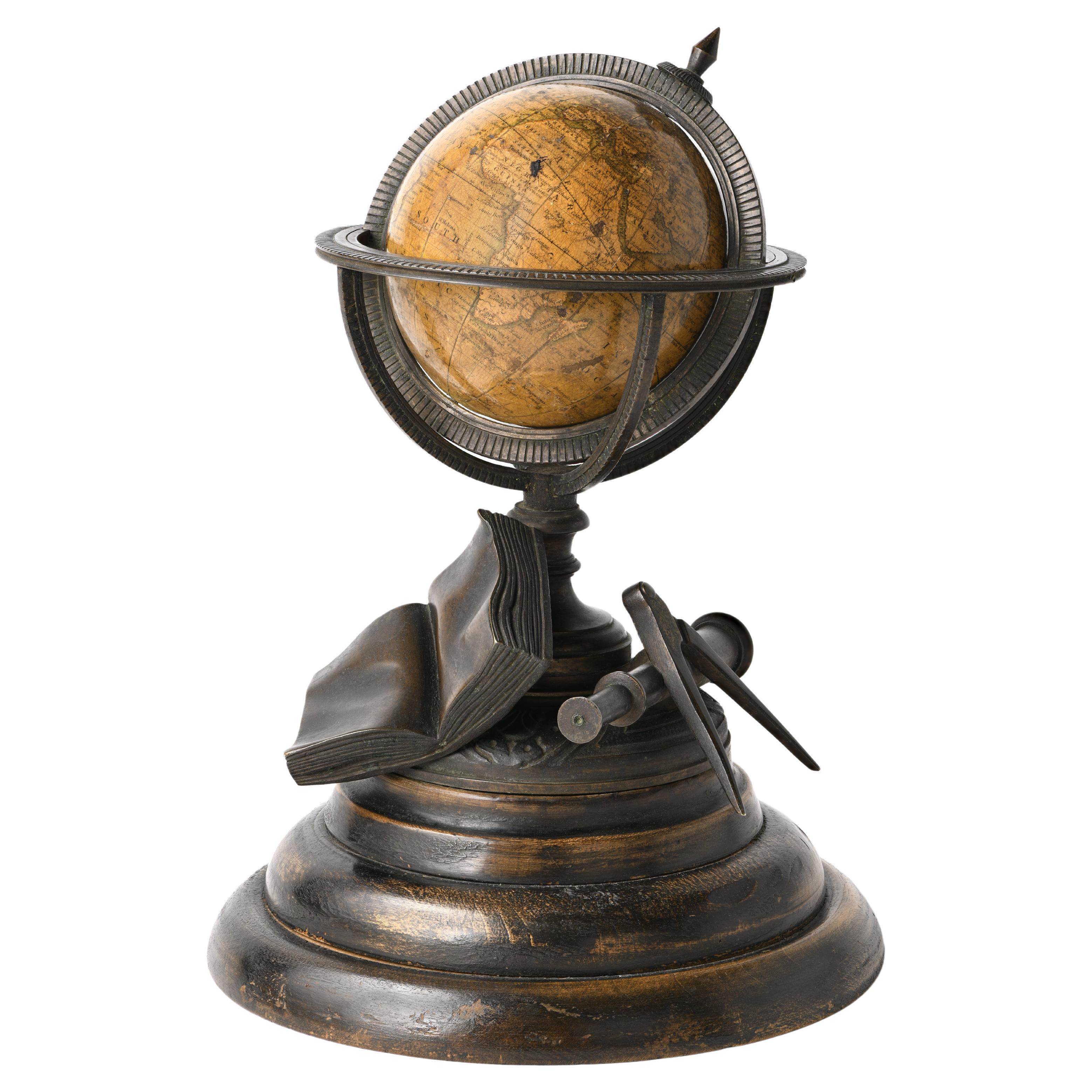Items Similar to Newton & Sons Late George III Terrestrial and Celestial Mahogany Library Globes
Want more images or videos?
Request additional images or videos from the seller
1 of 8
Newton & Sons Late George III Terrestrial and Celestial Mahogany Library Globes
About the Item
Fine pair of Newton & Sons late George III 20 inch terrestrial and celestial tripod mahogany library globes, London, second quarter of the 19th century,
the terrestrial globe, dated 1836, represents the most up-to-date geographical finding; the celestial globe, dated 1838 yet calculated to 1830 depicts the known heavenly bodies and the constellations; each with an inscribed brass meridian ring and an hour dial at each pole, and rotate both within, and at right angles to, the meridian circle line, the central engraved paper horizon on each is graduated in degrees of altitude and azimuth (the horizontal angle of a bearing measured clockwise from the north); also with compass bearings; the celestial also with a diagrammatic depiction of the sun's apparent path through the signs of the zodiac, days and months, further detailing the minutes and overall length of time before and/or after sunset and sunrise; each globe raised on four mahogany quadrant supports connected to a turned pedestal raised on three down-swept legs, terminating in brass casters.
Measures: Height to median ring 32 in., diameter of each globe 20 in.
Condition report.
Overall good condition with some restoration to legs and pedestals. Some printed lithography wear.
- Creator:Newton and Son (Maker)
- Dimensions:Height: 32 in (81.28 cm)Diameter: 20 in (50.8 cm)
- Materials and Techniques:
- Period:
- Date of Manufacture:1836
- Condition:Wear consistent with age and use.
- Seller Location:West Palm Beach, FL
- Reference Number:1stDibs: LU3860111764741
About the Seller
5.0
Vetted Seller
These experienced sellers undergo a comprehensive evaluation by our team of in-house experts.
Established in 1989
1stDibs seller since 2018
92 sales on 1stDibs
Typical response time: 8 hours
- ShippingRetrieving quote...Ships From: West Palm Beach , FL
- Return PolicyA return for this item may be initiated within 3 days of delivery.
More From This SellerView All
- Francois Linke Ecran de Foyer a ChassisBy François LinkeLocated in West Palm Beach, FLFrançois Linke, (1855-1946) Ecran de Foyer a Chassis Paris, early 20th century Carved giltwood and silk damask upholstery, with removable sliding screen...Category
Early 20th Century Screens and Room Dividers
MaterialsSilk
- Maison Lalande Mahogany Library Furniture, Paris, 1890-1900By Maison LalandeLocated in West Palm Beach, FLFine suite of Empire style ormolu-mounted mahogany library furniture, Maison Lalande, Paris, 1890-1900, comprising: a bureau plat, a large cartioneire and three tub chairs, each w...Category
Antique 1880s French Desks and Writing Tables
- Pair George II Style Carved Walnut Library Arm ChairsLocated in West Palm Beach, FLPair George II Style Carved Walnut Library Arm Chairs with tapestry fabric covers. Late 19th Century each with a upholstered back and seat, the arms with square incurved supports carved with husks and rising acanthus leaves and with scrolled snail-shell terminals. Height 47 in. (119.38 cm.), Width 25 in. (63.5 cm.), Depth 25...Category
20th Century Chairs
MaterialsCanvas
- George III Silver Circular Footed Serving TrayBy Richard RuggLocated in West Palm Beach, FLGeorge III Silver Circular Footed Serving Tray Marked, London, circa 1760, maker Richard Rugg. The applied border cast with open foliage interlaced scrolls and partial bead borders,...Category
Antique 18th Century Platters and Serveware
MaterialsSilver
- Empire Style Ormolu-Mounted Mahogany Marble Top Center Table, Late 19th CenturyLocated in West Palm Beach, FLAn Empire style ormolu-mounted mahogany marble top center table, late 19th century. The circular portoro marble top above a frieze applied with anthemia, rosettes and laurel wreaths, raised square tapered legs each headed by a female Egyptian bust...Category
Antique 19th Century Console Tables
MaterialsBronze
- Japanese Satsuma Style Censer and Cover, Late 19th CenturyLocated in West Palm Beach, FLJapanese Satsuma style censer and cover Late 19th century The bulbous body supported by four feet and set with two shishi han...Category
Antique Late 19th Century Ceramics
MaterialsCeramic
You May Also Like
- Newton and Son Pocket Globe and CaseBy Newton and SonLocated in Spencertown, NYThe terrestrial globe is 3 inches in diameter contained within a turned mahogany box with cover. The seas in light green and land masses in darker green. Dimension of Globe 3" Diame...Category
Antique Mid-19th Century English Victorian Globes
MaterialsFruitwood, Paper
- Large Terrestrial Library GlobeLocated in Nashville, TN30 inch diameter library globe featuring Oklahoma with Indian territory, circa 1890. Maker is Johnston, Edinburgh, Scotland, a renowned British globe pro...Category
Antique Late 19th Century Scottish Globes
MaterialsBrass
- Large and Extremely Rare Terrestrial Globe by NewtonBy Newton Globes - Planer & NewtonLocated in Lymington, HampshireA large and extremely rare 24-inch terrestrial globe by Newton Our most magnificent and rare globes were a pair of 24-inch Newton globes. These too were updated in 1852 (terre...Category
Antique Mid-19th Century English Globes
MaterialsMahogany
- Celestial Table Globe by Harris and SonLocated in Lymington, HampshireA 12 inch celestial table globe by Harris and Son, the horizon ring, with the original papers, set on four turned mahogany legs, the label statin...Category
Antique 1810s English Globes
MaterialsMahogany
- William IV Terrestrial And Celestial Floor Globes By J. W. CaryBy John & William CaryLocated in New Orleans, LAThis stately pair of William IV Terrestrial and Celestial Globes was crafted by the esteemed mapmaking firm J. & W. Cary, exuding the essence of late Regency-era elegance. Beyond the...Category
Antique 19th Century English Regency Globes
MaterialsMahogany
- Miniature Terrestrial Globe Newton & Son London, Post 1833, Ante 1858By Newton and SonLocated in Milano, ITMiniature Terrestrial Globe Newton & Son London, post 1833, ante 1858 Paper, papier-mâché, bronze and wood It measures: sphere diameter 2.95 in (7.6 cm); diameter of the wooden base 6.02 in (15.3 cm); height 8.36 in (21.24 cm). Weight: 2,067 lb. State of conservation: the globe still bears its original paint, but has various small gaps, abrasions and stains on the surface. The globe is hinged with two pins at the meridian circle, which is in turn inserted perpendicular to the horizon circle; this is supported by four semi-arches connected at the bottom by a small goblet-shaped foot, resting on a wooden bell-shaped base. Apart from the wooden base, the entire support structure is made of bronze; on the foot there are the scale reproductions of a compass, a telescope and an open book. The sphere is made of papier-mâché and is covered with twelve printed paper gores. In the North Pacific Ocean the globe bears a cartouche with the inscription (about 30% of the writing is illegible, but the missing parts can be easily integrated based on the rest): NEWTON’S New & Improved TERRESTRIAL Globe Published by Newton & Son 66 Chancery Lane LONDON On the globe, much of central Africa is empty and the great lakes Tanganyika and Victoria are not marked (Europeans would begin to explore the area after 1858). Canada is called "British Territory" and Alaska "Russian Territory" (it would become part of the United States in 1867). Australia already bears its modern name (until 1829 it had been called New Holland) and its coasts are completely designed; Tasmania is listed as an island (Matthew Flinders circumnavigated it in 1798). The routes of Cook's various voyages are plotted; both the route followed by Biscoe in 1831 and the "Land of Enderby" which he discovered on the coast of Antarctica, south of Africa, are marked. Bibliography P. Van der Krogt, Old Globes...Category
Antique 1840s English Early Victorian Maps
MaterialsBronze
Recently Viewed
View AllMore Ways To Browse
Home Library
Library Lable
Son Wood
Library Accent
Mahogany Library
Antique Home Library
Celestial Furniture
Collecting Antique Globes
George Iii Signed
George Pedestal Mahogany
Terrestrial Globe
Used Furniture Newton
Terrestrial Globes
Wood Tripod Pedestal
Meridian Furniture
George Iii Library
Antique Globes London
Used Furniture Meridian
